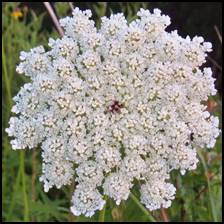You entered Bird’s Nest, the more common name is...

Queen Anne’s Lace
SCIENTIFIC NAME:(Daucus carota)
Queen Anne’s Lace is a flowering biennial plant in the Apiaceae family. Originating in temperate regions of Europe and southwest Asia it has since been naturalized to North America and Australia.
Queen Anne’s Lace has feathery, finely divided leaves (fern like) and a hairy stem that rises 2 to 4 feet in height. The showy white flower is shaped like an umbrella and is made up of many small white flowers in a lace-like pattern. At the center is a purplish-black floret. The root of Queen Anne’s Lace is thick and resembles a carrot. When in bloom, Queen Anne’s Lace looks like no other flower; without the showy white umbrella of florets, the leaves of the plant look like those of the domestic carrot and a pair of deadly relatives, poison Hemlock and Fool’s Parsley. To help correctly identify Queen Anne’s Lace remember the old adage, “Queen Ann has hairy legs” referring to the hairy stem which Hemlock and Fool’s Parsley do not have.
Queen Anne’s Lace is a member of the Apiaceae, or parsley, family. It is the ancestor of the domestic carrot, and is related to parsley, and the aforementioned poison hemlock and fool’s parsley.
Common Names:
Wild Carrot, Bird’s Nest, Bishop’s Lace

Uses:
Traditionally, tea made from the root of Queen Anne’s Lace has been used as diuretic to prevent and eliminate kidney stones, and to rid individuals of worms. Its seeds have been used for centuries as a contraceptive; they were prescribed by physicians as an abortifacient, a sort of “morning after” pill. The seeds have also been used as a remedy for hangovers, and the leaves and seeds are both used to settle the gastrointestinal system. It is still used by some women today as a contraceptive; a teaspoon of seeds are thoroughly chewed, swallowed and washed down with water or juice starting just before ovulation, during ovulation, and for one week thereafter. Grated wild carrot can be used for healing external wounds and internal ulcers. The thick sap is used as a remedy for cough and congestion. The root of Queen Anne’s Lace can be eaten as a vegetable just like carrots.Queen Anne’s Lace contains flavonoids, essential oils, vitamins B and C, pectin, lecithin, glutamine, phosphatide and cartotin, a vitamin A precursor.
Chinese research has confirmed the function of Queen Anne’s Lace seeds as an abortifacient; other research has shown the plant to be a bactericidal, a diuretic, a hypotensive, and an effective treatment for parasites.
An infusion of the leaves has been used to counter cystitis and kidney stone formation, and to diminish stones that have already formed.
Carrot leaves contain significant amounts of porphyrins, which stimulate the pituitary gland and lead to the release of increased levels of sex hormones.
You can collect the leaves and make your own tea or purchase the tea from many herbal companies.
Applications:
Tea:
Place torn leaves in cup and add boiling water. Allow to steep for 10 minutes then drain and drink. Can be reheated and sweetener can be added. However, do not add any milk product as this will decrease the teas potency.
Tincture:
Allow 3 Tbls of torn leaves to soak in ¼ cup of your favorite alcohol, like brandy or vodka.
Warnings:
Identification of this plant can be difficult and should be done by an expert before ingesting any part of the plant. Pregnant women and children should not use this plant with out a doctors supervision.
With any herb, there is the risk of an allergic reaction. Small children and pregnant women should use additional caution when considering the use of herbal remedies.





